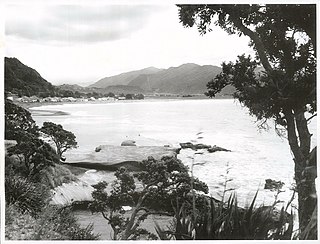Related Research Articles
Ruatoria is a town in the Waiapu Valley of the Gisborne Region in the northeastern corner of New Zealand's North Island. The town was originally known as Cross Roads then Manutahi and was later named Ruatorea in 1913, after the Māori Master female grower Tōrea who had some of the finest storage pits in her Iwi at the time. In 1925 the name was altered to "Ruatoria", although some texts retain the original spelling.

Ruatahuna is a small town in the remote country of Te Urewera, in the northeast of New Zealand's North Island. It is 90 kilometres directly west of Gisborne, and 18 kilometres northwest of Lake Waikaremoana. By road, it is 50 kilometres south-east of Murupara, and 110 kilometres north-west of Wairoa. It is on the upper reaches of the Whakatāne River, and surrounded on three sides by the Te Urewera protected area, formerly Te Urewera National Park. The road that runs from Murupara through Ruatahuna to Āniwaniwa on Lake Waikaremoana, a large part of which is unsealed, used to be designated as part of SH38. It is a subdivision of the Galatea-Murupara ward of the Whakatāne District.
Mohaka is a small settlement in the northern Hawke's Bay region of the eastern North Island of New Zealand. It is located on the coast of Hawke Bay, 20 kilometres southwest of Wairoa.
Nūhaka is a small settlement in the northern Hawke's Bay Region of New Zealand's eastern North Island, lying on State Highway 2 between Wairoa and Gisborne.

Te Araroa is a town in the Gisborne Region of the North Island of New Zealand. It is situated 175 km north of Gisborne city, along State Highway 35 between Tokata and Awatere. Te Araroa is the birthplace of noted Māori politician Sir Āpirana Ngata. Māori in the area are generally associated with the Ngāti Porou iwi. It is 100 metres from its local beach.
Ngāriki Kaipūtahi, Ngāriki Kaiputahi or Te Iwi o Ngāriki Kaipūtahi is a Māori iwi (tribe) in the Mangatu area of Gisborne District, New Zealand. Its present-day members are all descended from Rawiri Tamanui.

Te Aitanga-a-Mahaki is one of the three principal Māori iwi of the Tūranga district; the others being Rongowhakaata and Ngai Tamanuhiri. It is numerically the largest of the three, with 6,258 affiliated members as of 2013.

Raukokore is a small settlement close to the East Cape in the northeastern North Island of New Zealand. It is located on State Highway 35, close to the mouth of the Raukokore River, 40 kilometres to the west of Hicks Bay.
Patutahi is a small settlement 15 kilometres from Gisborne, in the northeast of New Zealand's North Island. It is located in the valley of the Waipaoa River.
Matawai is a small inland settlement in the Gisborne Region in the northeast of New Zealand's North Island. It is located on the upper reaches of the Motu River, in the Raukumara Range. It is on State Highway 2 between Gisborne and Opotiki.
Makaraka is an outer suburb of Gisborne, in New Zealand's North Island, located in the west of the city. The suburb features Gisborne's horse-racing circuit, Makaraka Racecourse. It is part of the statistical area of Makaraka-Awapuni, which is covered at Awapuni.
Ruatoki or Rūātoki is a district in the eastern Bay of Plenty of New Zealand, just south of the small town of Tāneatua and approximately 20 km south of the city of Whakatāne. The Whakatāne River runs northwards through the Ruatoki Valley and has formed broad alluvial flats. The main settlement of Ruatoki North is on the eastern side of the river.
Putere is a village and rural community located in the Wairoa District of the Hawke's Bay Region, on New Zealand's North Island. It is located based around the small Lake Rotoroa and Lake Rotonuiaha.
Muriwai is a settlement and rural community at the southern end of Poverty Bay, in the Gisborne District of New Zealand's North Island. It is located south of Manutuke State Highway 2.
Horoera is a village and rural community in Gisborne District of New Zealand's North Island. It is located east of Te Araroa and north of East Cape, at Horoera Point.
Ngatapa is a rural community in the Gisborne District of New Zealand's North Island.
Wharerata or Bartletts is a rural coastal community in the Gisborne District of New Zealand's North Island. It is located on State Highway 2 between Wairoa and Gisborne.
Waihirere is a settlement and rural area in the Gisborne District of New Zealand's North Island. It is located 16 kilometres inland from the coastal city of Gisborne.
References
- ↑ Hariss, Gavin. "Whatatutu, Gisborne". topomap.co.nz. NZ Topo Map.
- ↑ Bradley, Grant (18 February 2012). "Rewards and risks in quest for oil". New Zealand Media and Entertainment. New Zealand Herald.
- 1 2 3 "Te Kāhui Māngai directory". tkm.govt.nz. Te Puni Kōkiri.
- 1 2 3 "Māori Maps". maorimaps.com. Te Potiki National Trust.
- 1 2 "Marae Announcements" (Excel). growregions.govt.nz. Provincial Growth Fund. 9 October 2020.
Coordinates: 38°23′S177°50′E / 38.383°S 177.833°E